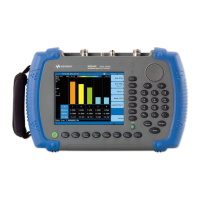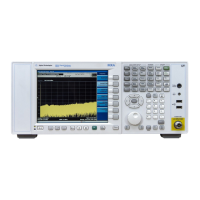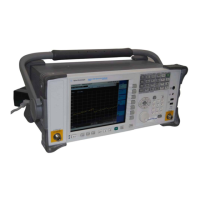Service Guide N5230-90014 4-43
PNA Series Microwave Network Analyzers Troubleshooting
N5230A Measurement System Troubleshooting
Checking Port 2 Power (B Signal)
The object of this check is to verify the power of the B signal across the entire frequency
range. Perform this test if there is an observed problem only with the channel B trace. The
ten second sweep is slow enough to allow you to observe the output power on the power
meter as the sweep occurs.
1. Connect the power sensor to Port 2.
2. Observe the power reading on the power meter as the sweep occurs on the analyzer.
3. The measured output power on the power meter should be approximately 0 dBm over
the entire frequency range.
• If the measured power is correct, go to “Checking the Receiver Group” on page 4-45.
• If the measured power is not correct, go to “Checking the Signal through the Signal
Separation Path” on page 4-43.
Checking the Signal through the Signal Separation Path
For all of the following checks, refer to the block diagrams at the end of this chapter and to:
• “Bottom Assemblies, Passive Configuration (Options F06 and F13)” on page 6-14
Port 1 trace loss in the signal separation group is due to one or more of the following
assemblies being defective:
• A19 SSLAM
• A25 step attenuator
• A21 test port 1 coupler
Port 2 trace loss in the signal separation group is due to one or more of the following
assemblies being defective:
• A19 SSLAM
• A26 step attenuator
• A22 test port 2 coupler
Equipment Used for These Tests
To determine which assembly is defective, check the signal at each available measurement
point in the signal path from the A19 SSLAM to the test port coupler.
For Port 1 measurements, set the network analyzer for an S
11
measurement with a CW
frequency of 1 GHz.
For Port 2 measurements, set the network analyzer for an S
22
measurement with a CW
frequency of 1 GHz.
Equipment Type
Model or
Part Number
Alternate Model or
Part Number
Spectrum analyzer 8565E
856xE
a
a. Must be capable of measuring a signal at 1 GHz.
